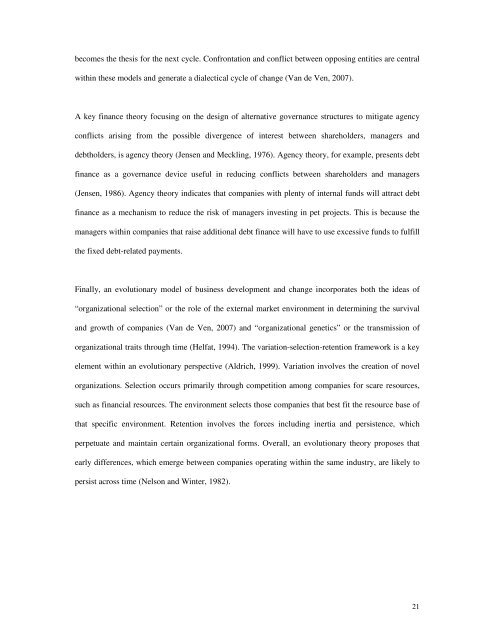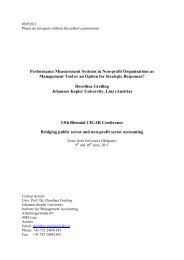Financing Unquoted High-Growth Companies: From Extending
Financing Unquoted High-Growth Companies: From Extending
Financing Unquoted High-Growth Companies: From Extending
You also want an ePaper? Increase the reach of your titles
YUMPU automatically turns print PDFs into web optimized ePapers that Google loves.
ecomes the thesis for the next cycle. Confrontation and conflict between opposing entities are central<br />
within these models and generate a dialectical cycle of change (Van de Ven, 2007).<br />
A key finance theory focusing on the design of alternative governance structures to mitigate agency<br />
conflicts arising from the possible divergence of interest between shareholders, managers and<br />
debtholders, is agency theory (Jensen and Meckling, 1976). Agency theory, for example, presents debt<br />
finance as a governance device useful in reducing conflicts between shareholders and managers<br />
(Jensen, 1986). Agency theory indicates that companies with plenty of internal funds will attract debt<br />
finance as a mechanism to reduce the risk of managers investing in pet projects. This is because the<br />
managers within companies that raise additional debt finance will have to use excessive funds to fulfill<br />
the fixed debt-related payments.<br />
Finally, an evolutionary model of business development and change incorporates both the ideas of<br />
“organizational selection” or the role of the external market environment in determining the survival<br />
and growth of companies (Van de Ven, 2007) and “organizational genetics” or the transmission of<br />
organizational traits through time (Helfat, 1994). The variation-selection-retention framework is a key<br />
element within an evolutionary perspective (Aldrich, 1999). Variation involves the creation of novel<br />
organizations. Selection occurs primarily through competition among companies for scare resources,<br />
such as financial resources. The environment selects those companies that best fit the resource base of<br />
that specific environment. Retention involves the forces including inertia and persistence, which<br />
perpetuate and maintain certain organizational forms. Overall, an evolutionary theory proposes that<br />
early differences, which emerge between companies operating within the same industry, are likely to<br />
persist across time (Nelson and Winter, 1982).<br />
21

















